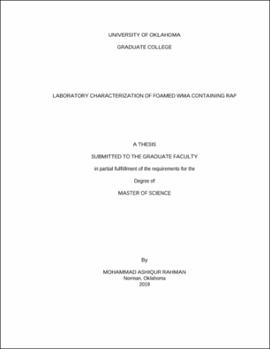| dc.contributor.advisor | Zaman, Musharraf | |
| dc.contributor.author | Rahman, Mohammad | |
| dc.date.accessioned | 2019-08-05T19:42:07Z | |
| dc.date.available | 2019-08-05T19:42:07Z | |
| dc.date.issued | 2019-08-01 | |
| dc.identifier.uri | https://hdl.handle.net/11244/321119 | |
| dc.description.abstract | For more than two decades, the asphalt paving industry has been using Reclaimed Asphalt Pavement (RAP) and various types of Warm Mix Asphalt (WMA) technologies in the production of asphalt mixes to reduce impact on the environment and promote sustainable construction. Despite their significant economic and environmental benefits, the validity of using volumetric mix design method for WMA mixes containing RAP and their performance remain a matter of concern. Among the current WMA technologies, the plant foaming technique (called “foamed WMA” in this study) has gained the most attention because it eliminates the need for using any chemical additives in this process. In this study, the mix design volumetrics and laboratory performances, namely rutting, cracking and moisture-induced damage potential of foamed WMA containing RAP were evaluated and compared with their Hot Mix Asphalt (HMA) counterparts. One coarse (S3) mix having a Nominal Maximum Aggregate Size (NMAS) of 19 mm and one fine (S4) mix (NMAS = 12.5 mm), containing 25% and 5% RAP, respectively, were used for evaluation.
It was found that the foaming process increased the coating ability of the binder which in turn lowered mixing and compaction temperatures for foamed WMA. Therefore, both HMA and foamed WMA exhibited similar mix design volumetrics up to certain lower mixing and compaction temperatures. However, further reduction in the mixing and compaction temperatures for foamed WMA was found to exhibit improper mixing between aggregates and binder. Also, to ensure presence of sufficient active binder from the RAP, it was found that the compaction temperature for foamed WMA should be greater than the high-temperature Performance Grade (PG) of the extracted RAP binder.
In spite of foamed WMA exhibiting similar volumetric properties as compared to those of HMA, their laboratory performance was found to be significantly different. The foamed WMA was found to exhibit a lower stiffness compared to HMA in the dynamic modulus test. The reduced aging at lower mixing and compaction temperatures is believed to be responsible for lowering the stiffness of foamed WMA compared to HMA. Also, an increase in RAP content was found to increase the stiffness of asphalt mixes due to incorporation of aged binder from RAP. A stiffer asphalt mix is expected to exhibit lower cracking resistance and higher rutting resistance. Therefore, foamed WMA was found to exhibit higher cracking resistance compared to HMA in Louisiana Semi-Circular Bend (SCB) and Illinois Flexibility Index Test (I-FIT) tests. A similar trend in the cracking resistance was observed for coarser mixes in the Abrasion Loss Test (commonly known as Cantabro test). However, the Cantabro test could not screen finer mixes for their cracking resistance as it lacks a mechanistic basis. The coarser mixes were found to exhibit lower cracking resistance compared to finer mixes due to higher RAP content and differences in crack propagation mechanisms. The rutting performance of foamed WMA was found to be of concern as they exhibited lower resistance compared to their HMA counterparts. Coarser mixes exhibited higher rutting resistance compared to finer mixes due to higher RAP content. The foamed WMA exhibited higher moisture-induced damage potential compared to HMA. The presence of moisture from partially dried aggregates at lower WMA mixing and compaction temperatures and use of water in the foaming process were reasons for the reduction in moisture-induced damage resistance for foamed WMA. The Moisture Induced Sensitivity Test (MIST) conditioning was found to be a better method for simulating moisture-induced damage potential of asphalt mixes than the AASHTO T 283 method. Application of adhesion cycles followed by loading cycles instead of a freeze-thaw cycle (AASHTO T 283) in the moisture conditioning process in MIST is believed to better represent field conditions. Also, increase in RAP content was found to lower moisture-induced damage potential due to strong bonding between RAP aggregate and binder. Therefore, the foamed WMA was found to increase cracking resistance, rutting potential and moisture-induced damage potential of asphalt mixes. On the contrary, addition of RAP was expected to reduce cracking resistance, rutting potential and moisture-induced damage potential. Therefore, foamed WMA containing RAP can exhibit mixed performance particularly when the RAP content is higher than certain level. | en_US |
| dc.language | en_US | en_US |
| dc.rights | Attribution-NoDerivatives 4.0 International | * |
| dc.rights.uri | https://creativecommons.org/licenses/by-nd/4.0/ | * |
| dc.subject | Foamed Warm Mix Asphalt (WMA) | en_US |
| dc.subject | Reclaimed Asphalt Pavement (RAP) | en_US |
| dc.subject | Mix Design Volumetric Properties | en_US |
| dc.subject | Rutting Resistance | en_US |
| dc.subject | Moisture-Induced Damage Potential | en_US |
| dc.subject | Fatigue Cracking Resistance | en_US |
| dc.title | Laboratory Characterization of Foamed WMA Containing RAP | en_US |
| dc.contributor.committeeMember | Miller, Gerald | |
| dc.contributor.committeeMember | Ghabchi, Rouzbeh | |
| dc.date.manuscript | 2019-07-31 | |
| dc.thesis.degree | Master of Science | en_US |
| ou.group | Gallogly College of Engineering::School of Civil Engineering and Environmental Science | en_US |
| shareok.orcid | 0000-0001-7855-5346 | en_US |

